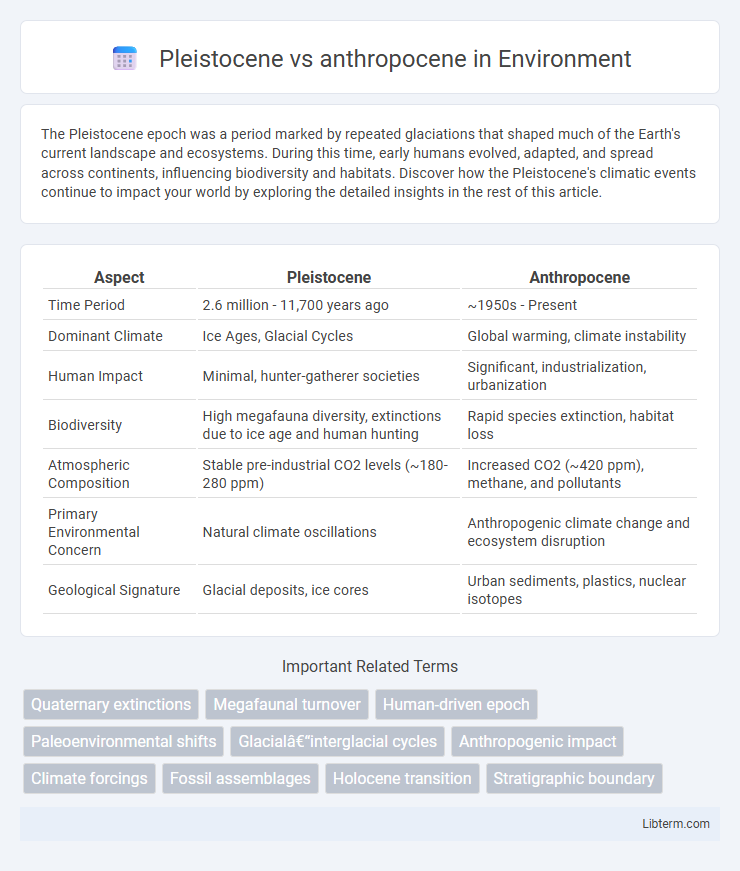The Pleistocene epoch was a period marked by repeated glaciations that shaped much of the Earth's current landscape and ecosystems. During this time, early humans evolved, adapted, and spread across continents, influencing biodiversity and habitats. Discover how the Pleistocene's climatic events continue to impact your world by exploring the detailed insights in the rest of this article.
Table of Comparison
| Aspect | Pleistocene | Anthropocene |
|---|---|---|
| Time Period | 2.6 million - 11,700 years ago | ~1950s - Present |
| Dominant Climate | Ice Ages, Glacial Cycles | Global warming, climate instability |
| Human Impact | Minimal, hunter-gatherer societies | Significant, industrialization, urbanization |
| Biodiversity | High megafauna diversity, extinctions due to ice age and human hunting | Rapid species extinction, habitat loss |
| Atmospheric Composition | Stable pre-industrial CO2 levels (~180-280 ppm) | Increased CO2 (~420 ppm), methane, and pollutants |
| Primary Environmental Concern | Natural climate oscillations | Anthropogenic climate change and ecosystem disruption |
| Geological Signature | Glacial deposits, ice cores | Urban sediments, plastics, nuclear isotopes |
Introduction: Defining the Pleistocene and Anthropocene
The Pleistocene epoch, spanning from about 2.6 million to 11,700 years ago, is characterized by repeated glacial cycles and significant megafaunal extinctions. The Anthropocene, a proposed epoch starting in the mid-20th century, marks the period when human activity began to exert a profound impact on Earth's geology and ecosystems. Defining these epochs highlights the transition from natural climatic fluctuations to widespread anthropogenic environmental changes.
Timeline Overview: When Did Each Epoch Occur?
The Pleistocene epoch spanned from about 2.6 million years ago to roughly 11,700 years ago, marked by repeated glacial cycles and the emergence of Homo sapiens. The Anthropocene, a proposed epoch, is characterized by significant human impact on the Earth's geology and ecosystems, beginning in the mid-20th century, often linked to the Great Acceleration post-World War II. This timeline reflects a transition from natural climate variability in the Pleistocene to human-driven environmental changes in the Anthropocene.
Climate Patterns: Ice Ages vs. Human-Driven Change
The Pleistocene epoch was defined by repeated ice ages characterized by natural cycles of glacial and interglacial periods influenced by Earth's orbital variations, causing large-scale climate fluctuations and extensive ice sheet coverage. In contrast, the Anthropocene epoch is marked by unprecedented human-driven climate change, primarily resulting from greenhouse gas emissions from industrialization, deforestation, and fossil fuel use, leading to rapid global warming and disruption of natural climate systems. Unlike the gradual and cyclical climate patterns of the Pleistocene, the Anthropocene exhibits accelerated and anthropogenically-induced climate shifts with significant impacts on ecosystems and sea levels.
Dominant Life Forms: Megafauna and Modern Humanity
During the Pleistocene epoch, dominant life forms included megafauna such as mammoths, saber-toothed cats, and giant ground sloths that thrived in diverse ecosystems. In contrast, the Anthropocene epoch is characterized by the dominance of modern humanity (Homo sapiens), whose activities have significantly altered the planet's ecosystems and biodiversity. The decline of Pleistocene megafauna is closely linked to human expansion and climate changes marking the transition to the Anthropocene.
Geological Evidence: Stratigraphy and Fossil Records
Geological evidence from stratigraphy reveals distinct sedimentary layers marking the Pleistocene characterized by glacial deposits and interglacial sediments, while the Anthropocene shows unique signatures like increased carbon and plastic pollutants. Fossil records during the Pleistocene document megafauna such as mammoths and saber-toothed cats, contrasted with Anthropocene deposits containing remnants of human-made materials and evidence of rapid biodiversity changes due to human activity. These stratigraphic and fossil distinctions provide critical data for differentiating Earth's natural historical epochs from the current human-influenced geological period.
Extinction Events: Natural Causes vs. Human Activities
Pleistocene extinction events were primarily driven by natural causes such as climate fluctuations, glacial cycles, and volcanic activity, which led to the loss of megafauna across multiple continents. In contrast, the Anthropocene extinction is significantly accelerated by human activities including habitat destruction, pollution, overhunting, and introduction of invasive species, causing rapid declines in biodiversity. Scientific data highlight that current extinction rates are estimated to be 100 to 1,000 times higher than the natural background rates observed during the Pleistocene epoch.
Human Evolution: From Early Hominins to Global Impact
The Pleistocene epoch marked significant milestones in human evolution, featuring the emergence of early hominins such as Homo habilis and Homo erectus, who developed tools and progressively complex social structures. In contrast, the Anthropocene epoch is characterized by Homo sapiens' transformative impact on the planet through industrialization, urbanization, and environmental modification on a global scale. This period underscores humanity's shift from evolutionary adaptation to shaping Earth's ecosystems and climate.
Environmental Transformations: Natural Forces vs. Anthropogenic Effects
The Pleistocene epoch underwent environmental transformations primarily driven by natural forces such as glacial cycles, volcanic activity, and tectonic shifts, which shaped ecosystems over millennia. In contrast, the Anthropocene is characterized by rapid, anthropogenic effects including industrial emissions, deforestation, and urbanization, causing unprecedented changes in climate, biodiversity, and biogeochemical cycles. These human-induced alterations exceed natural variability, leading to accelerated environmental degradation and global ecological instability.
Biodiversity Shifts: Evolution, Loss, and Adaptation
The Pleistocene epoch experienced significant biodiversity shifts driven by glacial cycles, which influenced species evolution, extinction, and migration patterns, shaping ecosystems through natural selection and adaptation. The Anthropocene, marked by human activity, accelerates biodiversity loss at unprecedented rates through habitat destruction, climate change, and invasive species introduction, disrupting evolutionary processes. Adaptation in the Anthropocene increasingly depends on species' resilience to anthropogenic pressures, with some evolving rapidly while others face extinction, highlighting urgent conservation challenges.
Legacy and Future: What Each Epoch Teaches Us
The Pleistocene epoch teaches the legacy of natural climate oscillations and megafaunal adaptations, shaping ecosystems over millennia. In contrast, the Anthropocene highlights humanity's unprecedented impact on global environments, emphasizing the need for sustainable practices. Together, these epochs inform future strategies for biodiversity conservation and climate resilience.
Pleistocene Infographic

 libterm.com
libterm.com